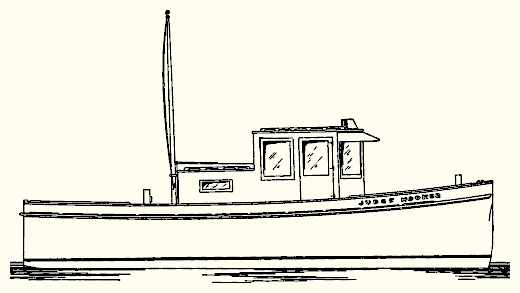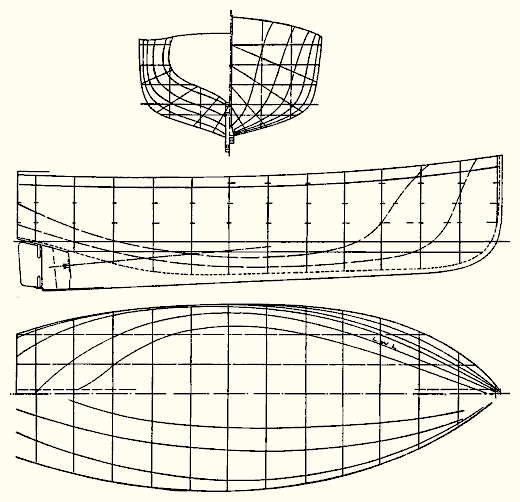
| Judge Hooker A 24' 2" Tugboat By William John Atkin |
| A Husky Little Tug | |
| Here are designs of a very useful boat. Despite modest dimensions, Judge Hooker is very able to do hard work around the water front anywhere where cargo and pleasure craft have to be towed into berths, alongside wharves, off sand bars, against strong tides, or out of dangerous positions. A really good tug boat can always find work, and they are profitable little craft to own and operate. This little hooker would be very useful as a harbor patrol boat. She is high sided, heavy, simple and practicable. With fire fighting equipment added her scope of usefulness would be increased greatly -- either chemical fire extinguishing equipment or a separate gasoline pump set installed beneath the after deck, and with suitable outlets each side the deck house for hose connections. | |

| |
The tug is 24 feet 2 inches in over all length; 24 feet on the water line; 9 feet 1 inch in breadth; and has a draft of 2 feet 6 inches. Freeboard at the bow to the edge of deck is 3 feet 9 inches, and at the stern 2 feet 10 1/2 inches. The bulwark rail is 7 inches high. She has sufficient breadth and firmness in her bilges to be stiff and will not easily "crank" when the tow line begins to pull athwartships. The lines show an easily driven form and one that will handle well and be at the same time a very able boat in rough water. The profile shows the simplest disposition of pilot house, engine house, bitts and hatches. It has the appearance of a full size harbor tug. Fact is, this latest of MoToR BoatinG's very large family, Judge Hooker, is much bigger than her dimensions indicate. The pilot house is 6 feet 3 inches long by 5 feet wide; the engine house, 3 feet 10 inches long and same width as pilot house. This leaves rather wide decks for so small a boat, 18 inches at the narrowest part and 21 inches amidships inside the rail cap. So there is room to walk aft. The pilot house stands 4 feet 3 inches above the deck, headroom being obtained by sinking the floor. It will be a big step down to the pilot house to be sure, but tug boats are not for the decrepit, so what matters this? The pilot house doors open out and forward and are 19 inches wide and so clear by inches the inner edge of the rail cap. I have found a pretty big man can easily pass through an 18 inch doorway. The forward sashes open out and are hinged at tops. This is simple and a cheap way to take care of these. Side sashes are fixed, after sashes same as forward sash. The pilot house inside has a seat across after end and ample room for the wheel box and motor clutch and controls. Headroom in the pilot house is 6 feet, under the house beams. | |

| |
| A sliding hatch gives into the engine room as shown, and a ladder leads below. Hatches give access to the space under the forward and after decks. There is a good deal of room here and it would be easy to arrange sleeping room if desired. There is also room for any type of small auxiliary water pumping plant if this should be required. It will be noticed that the fuel tanks are pretty much in the middle of the boat. The capacity of each tank is 65 gallons. | |

| |
The keel is straight and with very little drag. The rudder reaches the full depth of the deadwood and catches slip stream from the full diameter of the propeller, all of which helps steering ahead or astern. The after lines are fine, the water line being double-ended. A wide flat stern is not the right form for a successful tug boat, especially if the hull is of V bottom model. The latter form is very wasteful of power and not a good handling form. The lines, especially the sections, must be well balanced, and the dead-rise in perfect continuity if one expects to produce a successful tug boat, or for that matter any type boat designed for speeds under 12 miles an hour. And one cannot have perfect balance or sections with good continuity if the bow sections are of deep deadrise and the after sections flat. Just will not work in harmony and that is all there is to it. The motor shown in the plans is a six cylinder Hiawatha Red Wing of 282 cubic inch cylinder displacement; 52 h. p. at 1200 r.p.m. This will give a good 9 miles an hour, and will pull a heavy tow in smooth water at speeds up to 4.5 miles an hour. Since the form of the towed barges control the speed of a tow there is no way to state accurately just how many tons of load can be hauled. A properly designed barge of 200 tons will pull easier than a 30 ton barge of bad form. And most barges I have seen are of very bad form. | |
 PHOTOS OF JUDGE HOOKER PHOTOS OF JUDGE HOOKER 
| |
| Plans for Judge Hooker are $100 MYSTIC SEAPORT MUSEUM SHIPS PLANS STORE https://store.mysticseaport.org/ships-plans/ shipsplanstore@mysticseaport.org
+1 (860) 572 5360 | |
| BACK TO PLAN LIST | |